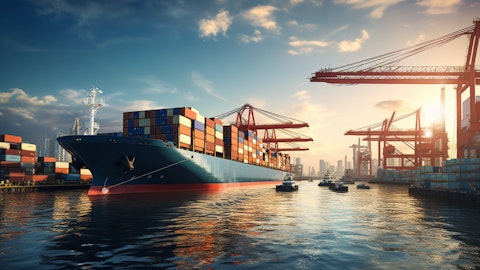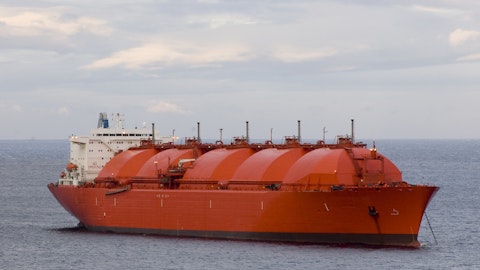If anything, they continue to move at quite strong volumes. Did that answer your question? Thank you
Bryan Degnan: I guess we have one here and then Chris you have a follow up and then come back to the top table.
Unidentified Analyst: Yes. Hi. Thanks for tall this. Maybe just to hear what your strategic thinking is on the dividend versus the buyback and how you guys thought about it in the beginning, starting last year, Q4 2022 and knowing where the strength is today. Obviously, I think 2019 you guys had about 30 to 35 in the STACK. Today, you’re about 42. So I just kind of hear some of your thinking on that and why you thought the dividend was the best drought?
Bart Kelleher: Sure, sure. So I think, I mean, one, I think coming back to the capital allocation policy and the fact that with the changing market backdrop and cash flow generation, that we could pursue all those priorities together and return of capital to shareholders was the important priority then we have waited a long time to be able to actually put into place. And I think we studied when we put the capital allocation policy in place, other industrial companies and well outside the shipping sphere. And it looked to and felt that a level that was one-third of earnings and in a cyclical business where you’re going to have fluctuations most seasonally and cyclically was actually quite significant within the industrial realm and sphere.
And then when we think about that and versus for example, a buyback and when we institute the policy and kind of thinking today as well. We like the liquidity and the average daily trading volume for our share and the 100% free float. And we felt that continuing to promote that while using the dividend as a tool for returning capital to shareholders was appropriate.
Unidentified Analyst: Appreciate the comments. Thank you. I’d be remiss if I didn’t ask about the E1 Marine investment. As you guys look at that, are you thinking more of licensing that technology in the future? Would you manufacture the units for sale to others? How are you looking to monetize that?
Bryan Degnan: I guess could I ask just for the benefit of the wider audience, maybe, what E1 marine is?
Bart Kelleher: Sure. I’ll give some backdrop. So as a reminder, when back a few years ago in 2021, the company made an investment in Element 1, which has proprietary technology to take methanol and produce pure hydrogen, which then can be used in a wide range of fuel cell applications. And important to remember that, that was actually a multifaceted deal that also put $40 million on the balance sheet in the terms of our preferred and that was a time when capital was really needed to bolster the company. It also coincided with the company’s energy transition plan and rollout. And so very early and important part of the company’s ETP plan, and then as we broadened that with examining this full range of technologies that we talked about that we’ve installed on our vessels, Element 1 remains one component to that.
Like other industrial companies where you have proprietary technology and then you’re looking to monetize that and achieve value on a global scale. They’ve been really active now in terms of their scaling, looking at different licenses across geographies and across verticals. So it’s actually not just marine and in fact, some of the other markets are accelerating more rapidly. So everything from aerospace off-highway, on-highway charging stations, so yes, so definitely significant progress there. I think we have to remind ourselves from our overall context that was a $10 million investment. So certainly when we think about our asset base, our fleet and our core competency in the fleet. But that happened to be a unique investment that met another criteria for the company.
But again, I think our ETP focus today and go forward is much more on testing and piloting technologies that then we can deploy on our fleet and improve from an operational perspective, but not necessarily making direct equity investments.
Bryan Degnan: Come to the front table here.
Unidentified Analyst: Thank you. I too have been wondering and struggling with demand. Every dollar chases away a customer at horizon or making it a negative $1,000. How have you seen customers economizing because obviously they want to save money and they’re being squeezed too? Can you give us some examples?
Anthony Gurnee: Can I just start and then just mentioned that the transport cost is roughly 5% of the delivered cost of fuel. And I think the real question is when oil traders are trading and they’re making a spread, what’s the impact on their decision?
Gernot Ruppelt: Yes, I think that almost answers the question entirely. I mean, I think as of yesterday, the 321 cracks, the refining margins were still at roughly $30 a barrel. So I guess they’re still making good money both in terms of refining and trading those commodities. And again, the fact that even though those higher freight levels are quite sticky, product is still moving, we are down. So we’re in peak U.S. Gulf refinery turnaround right now. U.S. Gulf PADD 3 rates are down to 77%, which is exceptionally low, normal run rates would be 92% to 95% maybe. And it’s not notable. I mean U.S. Gulf freight is as high as mid-30s on certain routes and as low as I think high-20s. So those are really good rates still. And again, we’re not at this point where we’re meeting inelastic demand for the transport of those goods. And again, at $30 a barrel at crack spreads, I think it’s – everybody still has a chance to make a lot of money.
Bryan Degnan: One more from the webcast. So one from webcast and we will have one more question up here. So this has been posed in a couple of different ways and Ben from in the room addressed this earlier as well. But Tony and so far as you said that you closed the presentation by saying that cycles inevitably end. I guess the through line for the various questions I’m getting is what do you do in the interim to make it worthwhile? What’s the point if it all eventually ends? How do you get there without it – I mean that the bigger question that sounded like? How do you start the next cycle, not at Square 1?
Anthony Gurnee: Okay. So if I understand the question, the end of the cycle is not the end of Ardmore Shipping. In fact, I get really excited in downturns because that’s where you build you make your money – you make your money when you buy. And if you asked me a year ago, what were we thinking? Well, if this ends, we’re going to be in a great position to build a fleet, right with cheap assets. So I think from an investor standpoint, it’s really important to understand this concept of potentially we’re in a long cycle, how long it’s going to last. For us, we’re playing the infinite game. And we’re going to keep playing it. And our objective is to build a great platform, perform every day but I build long-term value by making really good decisions on capital allocation.
Unidentified Analyst: Yes. Hi. Tony and team. As I look at everything you’ve talked about today, there’s been a lot of focus on demand, a lot of questions about demand. But you’re in a business where it’s the supply that matters. And also interestingly, I think the variables determining future supply are much more predictable. So I want to focus on those variables. First one is a year ago, I think you mentioned that the order book was particularly light because of uncertainty about what the environmental requirements of future levels are going given that they have such a long life that to be variable. So an update on that would be helpful? Second thing is, I look at a lot of other assets and equipment that moves around and in every category I can think of, the useful life is being increasing.
And so why might that be the case or it may not be the case in your industry? And then you also mentioned today just a lack of capacity – production capacity, how serious is that? And then my final question is what would it take you to order a new ship?
Anthony Gurnee: Okay. I’ll try to tackle the question. So I think the question on fuel is an interesting one. There are ships – a lot of ships are being ordered that are methanol dual fuel, nothing ammonia yet because the technology is not affected. But they’re all either in sectors that are very front facing to retail-type customers, so car carriers, container ships, et cetera, or they are more bulk-type businesses where the customer is prepared to give them a long-term time charter to kind of make it worth their while because it is a substantial increase in cost. So that is happening. Nobody is building dual fuel ships for spot trading because the market won’t pay for it. So that’s not happening yet. The ships are being built with engines that can be upgraded.
So the incremental cost now is not that much, but they could be retrofitted. So that is happening. But there still is a lot of uncertainty. So I think that definitely is a component of holding people back. Let me answer the last question first and then try to remember the ones in between. So – Would we order ships? Yes, possibly. It depends on when they deliver price, if they’re really connected to a project. If there are other strategic advantages to doing it. So it’s – I guess it was a question around shipyard capacity. The Clarksons tracks this, but I think the yard capacity from 2008 till today is down at least 50%. And you did not disappear in 2008; it took a while for yards to keep building and overpopulating the fleet and the yards going bankrupt, et cetera.
So there are I think there’s yard capacity there for orderly renewal replacement. I think there’s this wave of older ships that is not addressed. And that’s still to come, but it’s potentially a big issue. So I think I’ve missed at least two questions.
Unidentified Analyst: [Question Inaudible]
Anthony Gurnee: Oh, yes, that’s a good one because I get really frustrated with like dishwashers and things like that. So – there’s a long answer but the short answer, maybe we’ll do here, which is that I think in terms of the structural technology of ships and the way they’re being built and the way that the steel is being coded, et cetera, hasn’t really changed. And I think that means that for our ships, they’re going to last 20 to 25 years. And I don’t think there’s any initiative there should be, to be honest. I’m not sure it would help our economics all that much. But we should find ways to extend the life to build ships that have a longer life, anticipated life by way of modularity, upgrades, maybe better treatment of steel, et cetera. So – but am I missing anything in terms of construction technology that…



